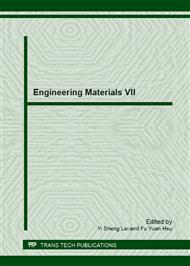p.95
p.105
p.113
p.121
p.127
p.131
p.137
p.143
p.151
Investigations of Lead-Free Glasses for Post-Fired and Embedded Thick Film Resistors
Abstract:
Lead-free thick film resistors (TFRs) were prepared by mixing of ruthenium oxide (RuO2) and CaO-B2O3-SiO2 based-glass. The resistors were post-fired on alumina and co-fired in LTCC substrates. Different metal oxides were added into the glass phase, such as Nb2O5, MnO2, MoO3, Fe2O3, TiO2. They were used as temperature coefficient of resistor (TCR) adjustment agents of the resistors. The microstructures variations and interactions at the interface between resistors and substrates were investigated. The additives made glass structure loose and conductivity of resistor decrease, the TCR values of the resistors moved toward negative direction. When 4wt% MnO2 was added into the glass, the thick-film resistors embedded in LTCC had conductivity of 2.46 (Ω-cm)-1, the temperature coefficient of resistor decreased to 12 ppm/°C. The conductivities of the resistors films were depended on the volume fractions of conductor-agglomeration (RuO2), microstructures, and TCR additives of the resistor layers
Info:
Periodical:
Pages:
137-142
Citation:
Online since:
September 2013
Authors:
Keywords:
Price:
Сopyright:
© 2014 Trans Tech Publications Ltd. All Rights Reserved
Share:
Citation:


